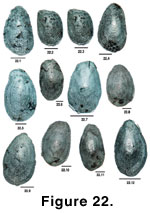 Description
DescriptionTheragra chalcogramma
(Walleye Pollock)
(Other common names: Pacific Pollock, Alaska Pollack; Bigeye, Scrapcod)
Figure 22.20
 Description
DescriptionLength: 90 cm.
Mouth: moderate, terminal; lower jaw slightly projecting; maxillary extends to front edge of pupil; teeth are small and slender.
Body: elongate; snout pointed; three separate dorsal fins, two anal fins with first beginning below front of second dorsal fin, caudal fin is slightly forked; chin barbel tiny or absent; lateral line high anteriorly, dipping mid-body; anus below space between first and second dorsal fin.
Color: brown to olive green on dorsal side with numerous brown spots; lighter on ventral side; fins are dusky to black.
Depth: surface to 366 m; diurnal migrations (Cohen et al., 1990).
Habitat: generally offshore; benthic on sandy/muddy substrate.
Season: little is known about its season cycle and reproduction.
Diet: crustaceans, forage fish (e.g., sand lance, herring).
Predators: marine mammals and larger fish.
Distribution: central California to Bering Sea; Kamchatka, Okhotsk Sea and Sea of Japan.
 Scale
Description
Scale
DescriptionRelative Scale Size: small.
Position of Scale on Body: not determined.
Overall Shape: mostly ovoid to tear-drop shaped.
Focus and Circuli: the focus is not centralized between the four fields and is approximately one-third of the total length from the anterior margin. The scales of this species are more tear-dropped shaped. The circuli are generally continuous but can be broken by the intermarkings, especially in the leading edges.
Radii: there are no radii, however, there are distinct intermarkings (sensu Batts, 1964), which are perpendicular or irregular "lines/structures" between the circuli. These intermarkings can align between the circuli to give a loosely similar appearance to radii.
Gadidae species scales do preserve well but they are often not entirely intact. They are quite brittle and easily subject to erosion, cracking, or breaking, often at the leading edges. The intermarkings are quite distinct for assignment to family. Scales recovered from sediments are often clear/transparent.